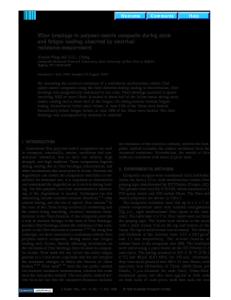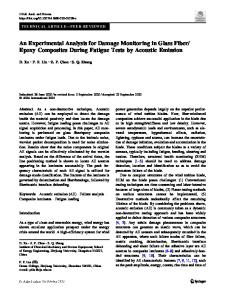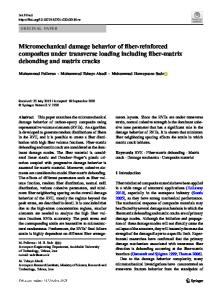Fiber Breakage In Polymer-Matrix Composites During Static And Fatigue Loading, Observed By Electrical Resistance Measure
- PDF / 396,353 Bytes
- 6 Pages / 414.72 x 648 pts Page_size
- 114 Downloads / 372 Views
top and bottom of the layup. No liquid mold release was necessary. The density and thickness of the laminate were 1.52 ± 0.01 g/cm 3 and 1.1 mm respectively. The volume fraction of carbon fibers in the composite was 58%. The laminates were cured using a cycle based on the ICI Fiberite C-5 cure cycle. The curing occurred at 355 ± 10°F (179 ± 6°C) and 89 psi (0.61 MPa) for 120 min. Afterward, they were cut to pieces of size 160 x 14 mm. Hence, each specimen had 38 bundles of fibers (6000 fibers per bundle, 7 pm diameter for each fiber). The resistivity of the composite was 4.1 x 10-3 and 2.04 Q.cm in the 00 and through-thickness directions respectively. The tensile strength was 1268 ± 89 MPa. The tensile ductility was 1.08 ± 0.08%. The Poisson ratio was 0.30. The electrical resistance R was measured in the longitudinal (fiber) direction using the four-probe method while either static or cyclic tension was applied in this direction. Silver paint was used for all electrical contacts. The four probes consisted of two outer current probes and two inner voltage probes. The resistance R refers to the sample resistance between the inner probes. The four electrical contacts were around the whole perimeter of the sample in four parallel planes that were perpendicular to the stress axis, such that the inner probes were 60 mm apart and the outer probes were 80 mm apart. A resistive strain gage was attached to the center of one of the largest opposite faces for measurement of strain in the stress direction. A Keithley 2001 multimeter was used for DC resistance measurement. The displacement rate was 1.0 mm/min, as provided by a hydraulic mechanical testing system (MTS 810). Tension-tension fatigue testing was performed with stress ratio (minimum stress to maximum stress in a cycle) 0.05 and maximum stress 740 MPa (at which strain = 0.56%). The fatigue test was run at a constant amplitude load level (load control). Each cycle took 1 s. A total of 396,854 cycles took place before fatigue failure. Multiple samples were tested to confirm that the results presented here are reproducible. RESULTS AND DISCUSSION Static loading Fig. 1(a) shows the tensile stress, strain and fractional change in electrical resistance AR/Ro in the stress direction (0°) obtained simultaneously during static tensile loading up to failure. The longitudinal AR/Ro first decreased until 0.5% strain. The decrease is due to increase in the degree of fiber alignment upon loading and decrease in the residual compressive stress in the fiber upon loading, as supported by the increase of the through-thickness resistance during loading [2] and decrease of the resistivity of a single carbon fiber embedded in epoxy upon loading [3]. Starting at 0.6% strain, the resistance increased in a stepwise fashion, due to spurts of fiber breakage. Accompanying the resistance increase was a slight decrease of the tangent modulus (slope of the stress-strain curve in Fig. 1(a)). That the modulus decrease was slight is because broken fibers still served as a reinforcement, although not
Data Loading...











